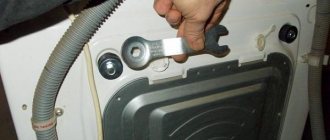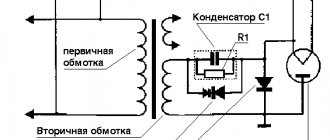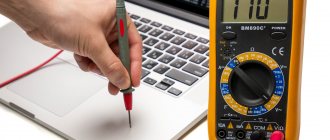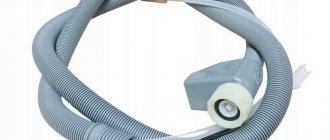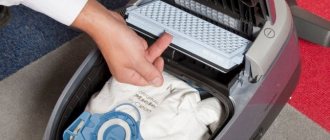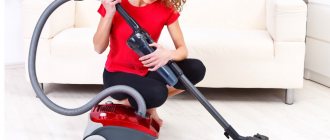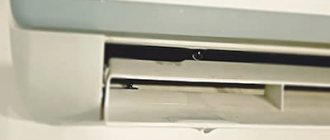When purchasing a washing machine (hereinafter also referred to as SM, ASM), most people expect that the unit will operate quietly. However, this does not always happen, and the owners do not know what is happening - maybe the machine is supposed to work this way. In fact, the washing machine makes noise during the spin cycle for several reasons.
Noise during operation of the washing machine causes a lot of trouble for owners
The most common causes of extraneous noise
There is nothing particularly complicated in the design of a washing machine. Therefore, there are not so many places where a malfunction can nest. It all depends on at what stage of washing the unusual noise and rattling occurs. The reasons why a loud noise is heard may be as follows:
- The bearing installed in the drum drive has become unusable.
- The mounting bolts holding the tank in place during transportation were not removed.
- The drive pulley is loose.
- The counterweights holding the drum are loose or crumbled.
- Some small objects got between the drum and the wall of the tank and got stuck there.
- The drain pump is broken.
- The rubber seal located on the hatch cover has crumbled or does not fit properly.
- The washing machine is not installed level.
See also -
Why does powder remain in the washing machine tray after washing?
Noise level
One of the important criteria for choosing a washing machine is the noise level emitted during operation. The indicators are specified in the technical data sheet of the device - decibels during operation and during spinning. Also, noise depends on the type of drive and seals used. They mainly produce machines with two levels:
- 40-55 dB;
- 55-75 dB.
To illustrate the example, the volume of human speech is 40-42 dB, soft background music is approximately 48-50 dB, 80 dB is equal to the sound of a powerful vacuum cleaner. Automatic washing machines with a noise rating below 70 are considered silent and comfortable for the user.
If extraneous noise appears in a measured sound - crackling, rumble or grinding, this is a serious reason to take urgent measures. You should be wary if:
- the noise level has increased compared to previous washes;
- there was a strong vibration during the spin cycle;
- The machine makes strange sounds - whistling, humming, grinding and others.
If, after washing, rusty spots appear on things or the color of the drained water becomes reddish, leaks occur - this is a reason to call a specialist for professional diagnostics. Popular problems can be fixed by yourself.
Bearings are damaged
This is a fairly complex breakdown that will require some skill to fix. But it’s not difficult to find it. You need to disconnect the washing machine from the network and spin the drum, pressing lightly on it. First twist clockwise, then counterclockwise. If the movement is intermittent, you hear a whistle, knocking and grinding noise - you can rest assured that the problem is in the bearings.
There is another way to detect the problem. The fact is that a leaky seal leads to bearing damage. When it is damaged, water gets in further and the bearing rusts and crumbles. You can see this by unscrewing the back panel. With such a malfunction, rusty streaks usually appear in the middle part of the tank.
If the cause is found, it must be corrected as quickly as possible.
Operating a washing machine with crushed bearings ends in damage to the bushing and shaft on which the drum sits. All this only aggravates the problem and increases the cost of repairs. See also:
A bra wire got into the washing machine
Possible causes of malfunction
If your newly installed washing machine is cracking, making a lot of noise, making noise and vibrating when spinning, you need to pay attention to the following.
- The transport bolts have not been removed. One of the most common mistakes made by both installers and those who do the installation themselves. The clamping bolts secure the shock-absorbing springs of the drum. When starting, the machine will begin to make a loud noise, during the spin cycle it will rumble and jump on the floor. It is necessary to immediately interrupt the wash cycle and unscrew the bolts, otherwise the drum may be damaged.
- Installing the machine on an uneven floor leads to vibration, rocking and knocking of the drum. To eliminate this, install screw-on legs, guided by the building level.
- The machine is installed close to the wall or furniture, rattling or rattling during the spin cycle. The clearance between the machine, wall or interior items should be at least 2-5 cm.
Also, a loud knock in the machine appears when installed on a shaky, sagging floor . Other causes of extraneous sounds are associated with breakdowns of mechanisms, non-compliance with operating rules, failure of electronics or a pump.
Drum overload with laundry
Overloading the washing machine drum with a large number of items or too bulky items provokes an imbalance in the spin cycle. The drum begins to beat loudly. If there is a one-time excess of laundry, nothing will happen to the machine. But with constant repetition of the situation, the bearings fail, the drive belt may break, and the door seal may become deformed.
If there is a strong overload, the imbalance sensor is triggered and turns off the automation. The problem can be solved by draining the water and removing some of the laundry. After this, the wash cycle is restarted.
Each model has a loading weight limit that must be strictly observed.
Bearing failure
Drum drive bearings wear out, like all moving parts. When one of the bearings fails, loud noise appears during operation. A malfunction leads to leakage, rust stains on clothing, play, grinding or jamming of the drum. You can diagnose a breakdown when the machine is empty and turned off. You should rotate the drum alternately in both directions. If you hear knocking and cracking sounds, it means you need to replace the old parts with new ones. Often the Indesit washing machine makes noise during the spin cycle due to bearing failure.
Shock absorber wear
Premature wear of parts designed to reduce vibration during spinning is associated with regular overload of the machine with laundry. Failure of the shock absorber on the tray side indicates the presence of leakage. In this case, the fastening rusts and becomes unusable. The machine makes loud noises and jumps during the spin cycle. But, even if one part fails, both must be replaced. Otherwise, the load on the new shock absorber will be greater and it will quickly fail.
Foreign objects in the tank
If you hear squeaks, rattles or crackling noises during operation, this means that foreign objects have entered the tank. Usually these are accessories from clothing, buttons, small items from pockets - change, pins, most often a bra wire. The reason is revealed simply - when you rotate an empty drum by hand, something rumbles inside. If objects get into the drain system, it will be difficult to drain water and the pump may be damaged.
There is no specific algorithm for solving the problem for all types of SM due to the design features. For some models, you can get into the tank by removing the heating element; for others, complete disassembly of the tank is acceptable. The work requires the use of professional tools and skills.
Motor fault
Wear on the electric motor brushes leads to humming and crackling noises, the washing machine does not reach speed during the spin cycle, the motor sparks and there is a burning smell. If such signs appear, you need to immediately disconnect the SM from the network. Wear and tear threatens failure of the motor and electronic board. The problem can be resolved by replacing the graphite cylinders with new ones. When working, you must follow safety precautions.
Pulley loosening
When the pulley is loosened, the drum begins to knock on the back wall. If the machine is more than 7 years old, physical wear of the part occurs, cracks or chips appear. The drum does not rotate well. The solution is to replace the pulley with a new one.
If the nut fastening to the shaft is loose, the machine “clicks” during operation, and over time the movement of the drum stops completely. It is necessary to tighten the loose nut or install a new one, placing it on the glue - sealant.
The counterweight is loose
To dampen vibration, a concrete counterweight is installed in the SM, which is secured with bolts. Over time, the fasteners may weaken and the concrete may crack. At the same time, during the spin function, the machine rumbles and vibrates strongly. The condition of the counterweight is checked by removing the back cover. If the reason is in the fastenings, tighten the bolts. If damaged, replacement will be required.
A separate item is directly driven LG machines produced before 2012, which are characterized by strong vibration and noise. This is justified by the design features - the engine is located behind the tank. The problem is eliminated by installing an additional counterweight from below.
The seal does not fit the hatch size
Incorrect installation, operation, temperature changes and humidity lead to deformation of the cuff that ensures the seal of the hatch. At the same time, a creaking noise is heard during the wash cycle, and during the spin cycle the machine begins to whistle.
To eliminate this, insert a piece of sandpaper between the seal and the wall and run a short wash without laundry. During the cycle, the sandpaper will erase the unevenness, all that remains is to rinse the drum.
The spring has flown off or worn out
When the spring is deformed, worn, or falls off the fastenings, a strong knocking sound is heard in the washing machine during the spin cycle. In this case, the tank is skewed and it knocks on the body. For diagnostics, remove the top cover. If the spring comes off, it is put back on. In case of damage, all elements are replaced with new ones. This is necessary for uniform stretching and positioning of the tank.
Faulty pump
If extraneous noise appears when water is drained during the spin cycle, or the pumping mode does not work, the shaft in the pump has broken down. At the same time, the machine hums, does not spin out the laundry well, and drains water every once in a while during rinsing. The breakdown is easy to diagnose - if pumping does not turn on in the drain mode, the pump needs to be replaced.
Transport bolts
For more careful transportation, special fastening bolts are provided in the washing machine body. They fix the shock-absorbing springs and prevent the tank from dangling from side to side. If the fasteners are not removed after installing the unit, the drum will rotate with a loud knock. What to do?
The problem can be solved very simply. You just need to unscrew the mounting bolts. The noise will stop. They are located in the back wall of the machine. By the way, this is written in great detail in each installation and operating instructions.
How to avoid trouble
What should the owner of a washing machine do to prevent it from making noise, rattling, crackling, rattling, creaking, vibrating, and also making beating, rustling, whistling, grinding and humming noises during operation for as long as possible? Everything ingenious is simple:
- First, carefully read the operating instructions;
- carefully follow all manufacturer's recommendations;
- Correctly assess your capabilities and seek help from professionals in case of complex breakdowns.
Following these three recommendations will be enough to prevent your washing machine from breaking down.
The pulley is loose
When the washing machine hums, makes noise and clicks loudly when the drum rotates, the problem may be that the drive pulley is weakening.
This is easy to check. Turn on the machine in test mode. If this is not the case, a hand wash mode or any other mode in which the drum rotates slowly will do. Listen carefully to the sound while looking at the drum. If every time you turn it you hear an extraneous noise, or rather a clicking sound, the pulley is most likely to blame. It's easy to fix the situation. Remove the back panel and locate the mounting nut that holds the pulley in position. Using a wrench of the appropriate size, eliminate the play by tightening the nut until it stops. If the noise during rotation disappears, then you did everything right. If not, we continue searching.
What to do if the noise is too loud?
Cases where the sound intensity from a washing machine operating in spin mode is too strong or unnatural in nature can be divided into two categories.
- The ones you can handle yourself.
- Requiring specialist intervention.
Solving the problem on your own
If the machine squeals hysterically during the spin cycle, adjust the belt tension. To do this, remove the back cover. Loosen the electric motor, move it so that when you lightly press the belt with your thumb, it bends no more than 5 mm. If it is impossible to perform such an operation (the engine is firmly installed), replace the belt completely.
If the drive belt has lost its elasticity, it must be replaced.
- If the loading hatch seal lip is clearly rubbing against the drum, try lubricating it with technical silicone. Determine whether your qualifications are sufficient to install it more tightly in a regular position, and do so.
- Make sure the drum shock absorbers are released. Otherwise, remove the clips.
- Use your hands to rock the counterweight stones. If you detect the slightest degree of freedom, tighten the fastening bolts.
- Level the machine horizontally. To do this, place a ruler with a water level (spirit level) diagonally on its top cover, unscrew or tighten the support legs from the desired side.
Repeat the operation in a different position. As an installation location, choose those where the capital structures of the building pass. For example, on floor beams. If this is not possible, reinforce the floor covering. For example, place waterproof Quick Deck chipboard under the washing machine.
Contacting service
If the bearings on the drum shaft have collapsed, then the only thing you can do is contact a service center. But you can check them at home.
Remove the back cover. Grab the pulley with your hand and turn the drum. In normal condition, it rotates easily, without resistance or noise. If you feel tremors and hear a hum, then the resource of this node is exhausted.
By the way, squealing of the drive belt can also happen for this reason - increased resistance during rotation leads to slippage. Therefore, when checking its tension, do not be lazy to move the shaft.
Not everyone knows how to test electric motor windings with a device; it is easier to detect a malfunction by smell. He's too typical. Repairs are only possible in a specialized workshop. It is often easier and cheaper to buy a new motor.
Counterweights
These rather heavy elements of the washing machine hold the unit's tank in place during the spin cycle. They are designed to dampen centrifugal force and counteract the rocking of the washing machine. If you hear a loud noise or rather a rattling noise when spinning the drum, check the counterweights. They are made of concrete, and it tends to deteriorate from old age.
Unscrew the back panel of the washing machine and carefully inspect the counterweights, shake them.
If the fasteners are loose, they need to be tightened by tightening the corresponding bolts tightly. If you find cracks on any of the counterweights, it is better to replace it completely. If this is not done, strong vibration may cause the counterweight to crack and damage the insides of the unit. Then you will have to repair a lot more. See also -
Shock absorbers for washing machines: do-it-yourself repair and replacement
Practical advice
A few simple tips will help you extend the life of your washing machine.
- Sorting laundry is not a whim of perfectionists. Try to wash together only items that are comparable in size and ability to absorb water.
- Remove large metal objects from your pockets. During spinning, they can damage rotating parts. In addition, their presence shifts the center of gravity and causes vibration.
- If you detect obvious signs of an emergency situation - increased noise, the appearance of abnormal sounds, odors, stop the washing machine. Immediately. The situation will not resolve itself.
- If necessary, interrupt the cycle, remove detected foreign objects or part of the loaded laundry. Don't forget to drain the water before doing this.
Now you know why your machine makes an excessive or unusual noise when spinning. As a rule, the problem can be solved on your own. Don't panic and do it.
Garbage and foreign objects
If you hear an unusual ringing, noise or grinding sound during washing or spinning, the reason may be that some foreign object has entered the tank. This often happens when housewives do not check their pockets very carefully. Such items can be nuts, coins, paper clips, bra underwires, metal buttons, and so on. What to do? How to eliminate extraneous noise?
We'll have to tinker. In order to look into the tank, you need to get to the heating element and unscrew it. Through the resulting hole, using long tweezers or just your fingers (if possible), remove objects that make an extraneous sound. Now you need to put the heating element in place, not forgetting to clean and degrease the rubber seal. It can be lubricated, for example, with liquid detergent.
Sometimes the problem can be solved much easier. Some models of “washing machines” have a special sump in which a filter is installed. In this case, you just need to open the sump door. It is most often located in the front. Now we just take out the filter and shake out everything that gets into it.
How to fix the problem yourself
Clean the drum
If the drum is not properly cared for, it becomes dirty, covered with limescale and rust. The main way to avoid dirt is to use water softener when washing. There are several ways to clean heavy stains:
- Cleaning with citric acid. Pour 200 g of the substance into the drum and start the washing cycle. In case of heavy contamination, repeat the cycle several times.
- Use of chlorine-containing substances (bleach, etc.). Advantages: high cleaning properties. Disadvantage: damage to rubber parts. Therefore, it can be used no more than once a year.
- Specialized cleaning products. They clean well from contaminants and do not destroy the parts and mechanisms of the device. The disadvantage is the high price.
Check transport fastenings and remove them if present.
Shipping bolts secure the tank when transporting the washing machine. They are removed before the first start. Technological holes for mounting bolts are placed on the rear panel evenly around the perimeter. There are usually 4 of them and they are clearly visible. They are unscrewed using a socket head or a wrench from the product kit. The fastening bolts are equipped with plastic bushings. Parts must be stored for use when transporting the device.
Check that the machine is installed correctly (using a level)
The position of the washing machine is adjusted by twisting legs and controlled by a level.
- Place a level on the top cover along the front wall.
- By adjusting the front legs, achieve zero level deviation from the horizontal.
- Place a level along the side panel. Adjust the height of the rear legs to achieve a horizontal level.
Adjust the hatch seal
Due to wear and tear, after improper installation, the door sealing lip begins to come into contact with the rotating drum. This may cause damage or leakage. Remedy:
- For replacement, use a cuff designed for a specific machine model.
- Loosen the clamp and remove the seal from the hatch.
- Unscrew the front panel, check the installation of the cuff on the tank - there should be no distortions, wrinkles, damage, etc.
- To eliminate defects, loosen the fastening clamp and install the seal correctly.
- Secure the clamp without overtightening it.
Check if the machine is overloaded with laundry
Overloading laundry leads to premature failure of the washing machine. If the machine is not equipped with an automatic laundry weighing function, you need to use the following rule. The drum cannot be filled more than 2/3 of the volume; the hand must freely penetrate into its upper part. For woolen fabrics the requirements are stricter: no more than 1/3 of the volume is filled.
When to call a specialist (if all the previous steps did not help)
If the washing machine is noisy, you must follow this rule: if the owner of the machine does not have special knowledge and skills in repairing washing equipment, and to fix the problem it is necessary to remove parts and mechanisms from their mounts and remove them from the body, it is better to invite a professional technician for such repairs.
During the warranty period, calling technicians from the service center is mandatory - otherwise the warranty may be void.
Faulty pump
Sometimes, when the washer hums and makes noise while draining water, the reason may be that the drain pump is damaged. You can try to correct the situation by cleaning the strainer. It is located on the front side of the unit, behind a special cover.
You also need to make sure that the drain pipe is clean. This is another reason why the machine began to make noise. Clean the pipe, it is likely that the noise will disappear.
If nothing helps and the unit still hums and rattles, things are bad. The drain pump has completely failed and will have to be replaced. To avoid mistakes, listen carefully to the operation of the unit. You can “suspect” the pump only if the “washing machine” makes noise only when filling or draining water, and the rest of the time it works quietly. The sound will be very similar to the noise of a running transformer.
Noise due to worn drum bearings
Another common cause of extraneous noise is failure of the drum bearings. It’s easy to check their condition; you don’t even have to disassemble the washing machine. You just need to turn the drum several times by hand. If it moves freely and no extraneous noise is heard during rotation, the bearings are normal. If a characteristic crunch is heard, the drum resists rotation - the bearings must be replaced.
Basically, washing machine bearings fail and create noise due to the drying out of the oil seal, which ensures the tightness of the drum. Water gets inside the bearing, it rusts and wears out quickly and begins to create noise. Therefore, if the problem is caused by the bearing, you must immediately change the oil seal, otherwise you will soon have to disassemble the device again.
The degree of complexity of the bearing replacement procedure depends on the model and manufacturer of the washing machine. The procedure is different for machines manufactured by Samsung, Ariston, LG and others. Before getting down to work, it would be a good idea to study the disassembly instructions for a specific model and watch a video on the topic.
In general, work to eliminate noise is carried out in the following sequence:
- The top cover of the washing machine is removed.
- The dispenser is removed and the control panel is removed.
- The front panel is removed; as a rule, the bolts securing it are hidden under the cuff.
- The screws holding the back cover are unscrewed.
- The heating element is disconnected and removed.
- The engine is removed.
- The tank is removed.
Next you need to disassemble the tank. In most cases, it consists of two halves bolted together. Worn bearings are removed and others are pressed in. New bearings must be of the closed type, otherwise they will not come out for a long time. After this, the device is assembled in the reverse order.
Rubber compressor
It happens that during operation, and especially during spinning, the washing machine whistles.
In this case, you find rubber shavings on the cover or walls of the hatch. Most likely it's the seal. This most often happens with inexpensive models of washing machines. Of course, it is best to replace the seal and choose a new one that fits in size. But you can try to solve the problem with the help of advice from folk craftsmen. Take a small piece of sandpaper and insert it between the front wall and the rubber seal. Now run any wash cycle that is at least half an hour long. There is no need to put laundry down. Sandpaper will help you adjust the elastic to size. All you have to do is take it out and remove the rubber debris from the machine. To do this, run an additional rinse cycle and then clean all filters.
DIY machine repair
To repair a machine yourself, you need to know its structure and operating principle. As a rule, repairs involve replacing old parts with new ones. When troubleshooting, you must first disconnect the machine from the power supply.
To replace parts yourself, you need to have a standard set of tools, and to repair the control board or electronics, you may also need a soldering iron.
Cleaning the drain filter
The first thing a washing machine owner can do is clean the filter. It often happens that small items of clothing or threads get there, which subsequently prevent the water from draining from the washing machine. To do this, you need to open the small cover located at the bottom of the machine and unscrew the small plastic plug using pliers.
After this, you need to clean the filter and rinse it under running water.
Cleaning the fill filter
This filter is located in the water intake hole. It can become clogged with small particles of dust or sand. To do this, you need to unscrew the inlet hose and use pliers to pull out the filter - a small plastic mesh that needs to be rinsed under water.
Replacing the heating element
If the repair involves replacing the heating element, you must first remove the back cover of the machine. Then disconnect the terminals and use a multimeter to check the element for functionality. The faulty heating element must be unscrewed using a wrench. After the old heating element is removed, you need to replace it with a new one. Be sure to install all parts in the correct order.
These are the most common types of repairs that you can easily carry out yourself. For more serious damage, it is better to contact a specialist.
Incorrect installation of the washing machine
Sometimes the answer to the question why a home laundry machine rattles and rattles during washing, especially during the spin cycle, is that it is simply not installed correctly. We are not talking about the electrical part here, but simply about its physical location. If the unit is not installed level, then when rotating at high speeds, for example, during a spin cycle, the centrifugal force will unbalance it. This leads to the following consequences:
- strong vibration is observed;
- the body of the car sways or “jumps”, moving from its place;
- A strong knocking and beating of the drum is heard.
To correct the situation, nothing needs to be repaired. All you need to do is set the washing machine level by tightening the legs. The sound should disappear.
If, after checking all the reasons described above, you still have not found the reason why the washing machine makes unusual sounds, the problem may be in the electric motor or the “wired” part of the unit. You can’t do this without special skills. It's best to call a professional. Using a multimeter, he will carefully “ring” all suspicious places and determine the cause of the hazing sounds.
Tips for avoiding malfunctions
- Observe the permissible load during washing - leave the drum one third empty.
- Perform preventative cleaning between work cycles.
- Try to use programs with high water heating as little as possible.
- Open the door after each wash to allow the machine to dry.
- If you wash several times a day, take breaks of 30 minutes.
- Leaving the washing machine idle for a long time causes the lubricant to evaporate and dry out.
- For budget models, components quickly wear out or wear out.
- Follow the rules for transportation, installation and connection to communications.
Watch the video about why the washing machine is noisy
Prevention
In order to invite a technician into your home as little as possible, it is enough to follow simple rules for operating the washing unit. This will not only extend its service life, but also save you from unnecessary hassle. What are these rules?
- Do not overload the machine. It is better to put a little less laundry in it than required according to the instructions.
- Try to do laundry no more than once a day. This will avoid additional stress on the parts. The washing machine will have time to cool down and dry thoroughly.
- Clean all possible filters regularly. You can also install additional water purifiers if necessary.
- Clean your machine from limescale deposits more often. Use special tools for this and follow the instructions.
- If possible, run the boiling program and spin mode at maximum speed as often as possible. If you do this often, components and parts will fail much faster.
- Before putting things in the machine, do not forget to carefully inspect the pockets and folds. Keep buttons and zippers fastened, and use a special bag for washing bras. All these precautions will save you from “fishing out” small objects from the bottom of the drum.
And remember: you shouldn’t delay the repair of the “home laundry”. If you ignore the problem at the initial stage, the matter may worsen and then the repair will cost much more.
See also:
- 10 Best Top Loading Washing Machines
- 10 best Hotpoint-Ariston washing machines according to customer reviews
- 10 best Electrolux washing machines according to customer reviews
- 10 best ATLANT washing machines according to customer reviews
- 10 best built-in washing machines
Loud noise when draining water
A special case is that the washing machine works fine, but as soon as the water needs to be drained, it makes a lot of noise. The cause may be a dirty drain filter or a faulty pump. Before handling the pump, you should remove and clean the filter. If it is in order, you need to remove and check the pump.
In most cases, high noise levels during operation of the drain pump are caused by contamination of the impeller or difficult shaft rotation. If so, then it is enough to remove the pump, wash it and the housing, and it is quite possible that the volume of the machine will noticeably decrease.
Troubleshooting and troubleshooting
According to consumer reviews, squeaking occurs in many washing machines. Both Whirlpool and Atlant with Hotpoint Ariston and many well-known brands squeak. There is no point in blaming design features - the internal structure of each brand and model is far from the same.
Squeaking also manifests itself in different ways during washing. More often, an unpleasant sound is heard throughout the entire cycle at intervals of five minutes, but sometimes it is heard 3 times during the entire program. It’s harder for those whose cars beep every five seconds.
In addition to sound, there may also be blinking indicators on the dashboard. Some units illuminate with a temperature light, others with a mode selector, and still others with all the buttons and keys.
In most cases, the squeak does not interfere with the washer’s ability to complete its tasks. It’s worse if the squeaking is accompanied by problematic operation. For example, the machine system resets the running program and ends the cycle ahead of schedule. You have to restart the mode and waste time on the next wash setting. As a rule, such a reset occurs chaotically, approximately once every 3-4 startup attempts.
Squeaking in the ATLANT typewriter
All of the above does not apply to owners of the Atlant 50C82 series washing machine. This machine also beeps, but it does it a little differently and for a completely different reason. Here the display unit and the program switching unit are to blame for the annoying sounds.
The squeak is explained as follows: the display unit only works in conjunction with the mode switch, which is not of a reliable design. The reason for the squeaking sound is in the gear selector.
It is worth noting that squeaking does not affect the performance of the washing machine. It is extremely rare that failures may occur in the form of erroneous display of one program on the display instead of the one selected by the user. For example, the regulator stops at the “Cotton” mode, and the indicator shows the time and temperature for “Quick Wash”. Sometimes the “SEL” error appears at the same time, which stands for “selector malfunction.” At Atlant, the squeak is eliminated by replacing the display module. You can try to repair it, but often the breakdown comes back again.
Source
